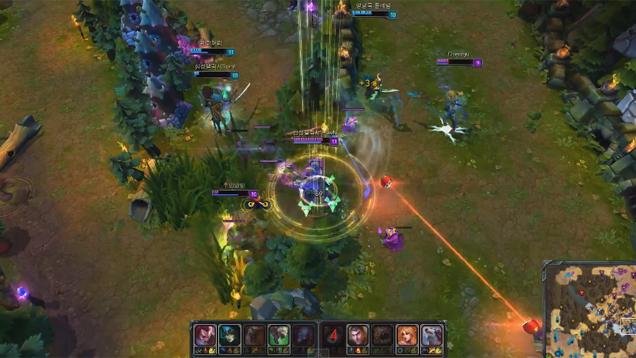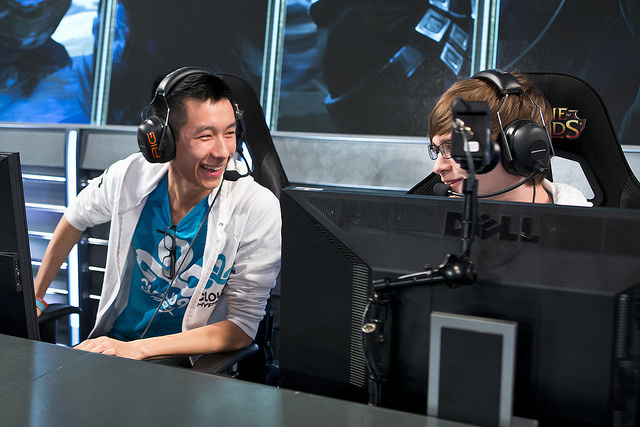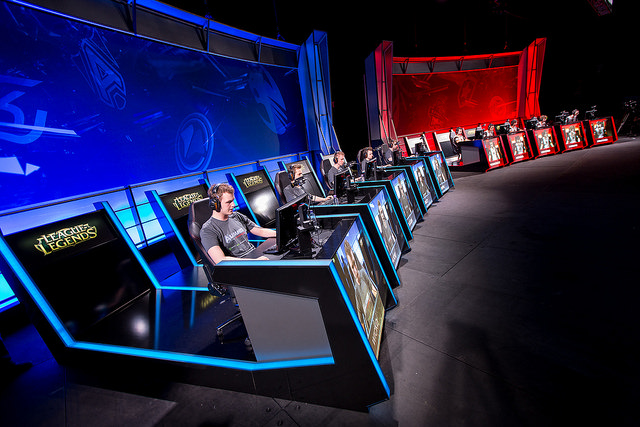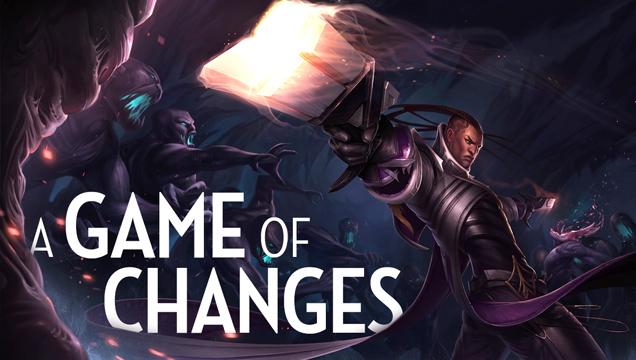You could almost hear a hundred thousand viewers collectively hold their breath. Shen’s ultimate move, Stand United, which grants his ally a shield for up to five seconds and teleports him to their location after three, had been interrupted. The game was paused.
Hundreds of gamers in attendance at Riot Games’ League of Legends Championship Series stage in Manhattan Beach, California, and thousands watching on Twitch, YouTube and Azubu were excitedly watching Week 10 of the North American Summer Split. The two teams battling it out, Team Curse and Evil Geniuses, were relatively close in the standings, but one side stood to gain considerable ground on the other given a victory, despite this just being a regular season match.
The game had to be paused. Officials needed to check what had just happened. (You can see the moment yourself about 21:40 into the video below.)
LCS rules state that, “If a game experiences a critical bug at any point during the match, which significantly alters game stats or gameplay mechanics,” the team it negatively effects may decide to restart the match. For months Shen had been disabled thanks to a bug, preventing him from appearing by his companion’s side. But the latest patch reported that the issue had been fixed.
Upon casting his champion’s ultimate move, Curse’s Diego “Quas” Ruiz believed that that exact bug had taken place. So he followed protocol by pausing the game and alerting an LCS official. Riot’s control room then checked to see if the bug was “critical and verifiable,” making sure that it was indeed damaging to the outcome of the situation and not caused by player error. Either his teammate had died before the spell finished casting or the bug occurred and Team Curse would undoubtedly choose to restart the game.
Everyone, the casters included, breathed a sigh of relief when it was confirmed that the bug had not occurred. Both teams were in the clear, the match would go on.
An Ever-Evolving Game
Save for a few major overhauls, professional sports largely remain the same year in and year out. No matter what changes, baseball will always have its bats, hockey its pucks, and basketball its hoops. To that extent, eSports will always use computers, monitors, and keyboards. But unlike traditional sports, the ever growing eSports scene has an additional factor that keeps each and every month different than the last: frequent changes to the game itself.

Unlike organisations such as NASCAR or the NHL, the people behind League of Legends, Riot Games, have to cater to both professional players and the millions of others, who spend hundreds of thousands of hours per day, seeking victory on the Fields of Justice. This brings about certain issues when it comes to balancing champions, items, and the map itself. An aspect of the game that’s hugely positive for casual players may get abused by those fighting for a paycheck during the LCS and deemed toxic to proper gameplay.
As a result, the studio routinely releases updates to the game in the form of patches. These most often contain changes that increase a champion’s power (buffs) or decrease them (nerfs). Sometimes the problem can be so deep, in either direction, that Riot has to completely overhaul a skillset, as has been the case many times in the past and many times to come.
An aspect of the game that’s hugely positive for casual players may get abused by those fighting for a paycheck.
The latest League of Legends patch introduced a plethora of changes made by the Live Design team, commonly referred to as the champion balancing team, in an effort to ready the game for the upcoming World Championship. Included was a nerf to Gragas’ area of effect (AoE) attack. His wave-clear — how quickly he can kill a wave of minions — was just too fast. Riot decided to nerf that, making it so that his Barrel Roll would only do 70 per cent of it’s normal damage to minions. Kayle’s Righteous Fury attack received an increase in how well it scales with ability power (AP), for every one point of AP, each of her basic attacks now does .25 additional damage. Other champions like Graves simply do more flat damage, as his ultimate ability, Collateral Damage, now does 250/400/550, depending on what level the skill is, instead of 250/350/550. In essence this makes Graves a tiny bit stronger during the mid game period when most champs are between the levels of 10 and 13.
When significant enough changes occur, Riot has a policy in place to prevent abuse. The LCS rulebook states, “Champions who have not been available on the live service for more than 4 weeks will be automatically restricted. Champions that have undergone reworks will be subject to LCS discretion.”
When Changes Misfire
The Marksman Lucian has been a highly contested pick since North America and Europe realised his true potential after he was made available. Champions such as him, called attack damage carries (ADC), often referred to as an AD Carry, are meant to deal out the most damage on the team, especially to global objectives like towers.
Overall however, the power of these AD Carries had been notably trending downwards towards the end of this year’s Spring Split. Riot Games decided to overhaul the itemization path that many Marksman typically build. With this, certain champions fell out of favour and others rose to the pinnacle. Lucian himself fell into the latter half, more powerful than ever.
Riot decided Lucian didn’t have any discernible weaknesses, so with the latest patch they tried to instill some vulnerability in his play. They decreased his range and increased his mobility, hoping to make his play a little more dangerous. Unfortunately those changes ended up being a pretty massive buff, as Riot overlooked the fact that his dash removed all active slows.
Players continuously exploited a change made to Lucian. Riot decided to globally ban him during competitive play, eliminating him from being chosen until the next patch is live.
Each time Lucian casts a spell, his passive ability makes it so that his next auto attack strikes twice. On the previous patch, his dash used to reset whenever he got a kill with his ultimate move, but now it simply decreases each time his passive activates. This allows his dash to now be available every five seconds, significantly lower than its actual cooldown. Because of the fact that the move eliminated all slow debuffs on him, it practically made him immune to being caught, something that players continuously exploited. Riot decided to globally ban him during competitive play, eliminating him from being chosen until the next patch is live.
Each player has a champion pool that they’re comfortable choosing from, and while buffs and nerfs can expand or shrink that pool, sometimes a perfect storm wreaks havoc with a player’s performance.

Cloud 9’s mid laner Hai “Hai” Du Lam (above) has been dominant throughout his stint in the North American LCS. However, both he and his team have struggled duringthe 2014 Summer Split, which started in May and goes into the postseason on Sunday. A large part of their issues have been changes to the meta, orwhat pros consider the “best” champions to play based on favourable matchups. Hai rose to prominence when AD Assassins were the standard, but this particular split they have sharply fallen away, resulting in Hai underperforming as he attempts to master champions that his opponents are more comfortable on.
Change For The Better
Almost everything in the game can be changed, a direct reflection of Riot’s evolution design value. Last November, the entire way vision worked was tweaked, adding an additional item slot allocated to one of three trinket items, giving each and every player a way to help the vision war. Items are balanced, retuned, removed, or added depending on what the developer feels is necessary. Even the game’s signature map, Summoner’s Rift, is itself is due for a major overhaul following the conclusion of this year’s World Championship. While the map will retain the same fundamental structure, the overhauled visuals and updated neutral monsters will surely have an impact on professional play.
“Our commitment to evolution means we can keep League healthy and dynamic over a number of years,” reads the design value blog. “Mistakes will be made along the way, but with player feedback and consistent iteration, we can create a constantly improving, ever-evolving game.”
Champions can actually go through pretty significant identity changes. When Kha’Zix was released, his ultimate, Evolved Active Camouflage granted him 40 per cent damage reduction, meaning those that attacked him did less damage. It was later increased to 50 per cent, but a year later it would quickly become an issue. Kha’Zix simply did too much damage while remaining too hard to kill. Riot Games would completely roll back on their initial design decision, removing all damage reduction that came with activating his ult. This left him only with the ability to go invisible for up to two seconds, 40 per cent bonus movement speed, and removing unit collision.
Other times there’s almost nothing Riot can do without receiving significant backlash. The champion Lee Sin is arguably the best and most popular jungler in League of Legends and has been for years. Almost everyone, besides players that mainly utilise the champion, probably understood that his strength was not great for the game itself and would be open to some amount of change. Live Balance Designer RiotChun, along with the Live Design team, proposed an abundance of changes that would hopefully bring Lee Sin back in an acceptable range of power. However, community backlash would make Riot shy away from actually going through with it.
Riot: “Mistakes will be made along the way, but with player feedback and consistent iteration, we can create a constantly improving, ever-evolving game.”
Most players, professional or otherwise, seem content with the frequency of patches released. More often than not it’s the timing of said patches that players react negatively to. With each region of competitive League of Legends on a different format and schedule it’s hard for Riot to keep the playing field completely even. A change during the LCS regular season could be happening during a crucial moment of playoffs in one of the Asian leagues such as the Garena Pro League (GPL) which is currently in its semifinals stage. Inevitably the changes or scheduling gives one region an advantage over others or stands as a rather large inconvenience, but it’s all just a part of being a professional League of Legends player.

Because of situations like Hai Du Lam’s and the impossibility for Riot Games to make the right decision every time, there is a constant ebb and flow in strength among professional teams. Some are quicker to innovate, catching onto something that they can exploit, others are simply prompt to adapt those techniques into their own strategy. Those that do, succeed and those that don’t fall behind.
Instead of raw skill itself, oftentimes it’s this resilience to harmonise with the state of the game that determines a player’s longevity. With many pros retiring before the age of 21 it’s rare to see veterans play for more than a couple of years – more often than not they flare up before slowly fading from relevance. A storied career is not common, but masterfully adapt to patches, small and large, and players just might stay relevant long enough to leave a lasting imprint in the minds of those watching.
Dillon Skiffington is an avid League of Legends player and a devoted follower of the LCS. He’s always open to discussing eSports over on Twitter. Disclosure: The author is a contributing writer for Leaguepedia, a website owned by Team Curse. He also has been contracted to write for LoL eSports, a site owned by Riot Games.
Pictures: Riot’s Flickr page

Comments
3 responses to “The Good And Bad Of League Of Legends Patches”
You know if you dont play the rigid meta, you get reported and banned, how are they gona patch that?
Yep, this is what has caused me to stop playing on SR unless I can get a 5-man team of people I know (which doesn’t happen any more). Try to do anything fun or non-meta and it’s “OMG REPORT THIS PLAYER”.
Oceania doesn’t have the tribunal working yet. But I agree, the best fun playing lol is with 4 friends. You can try all kinds of goofy stuff.